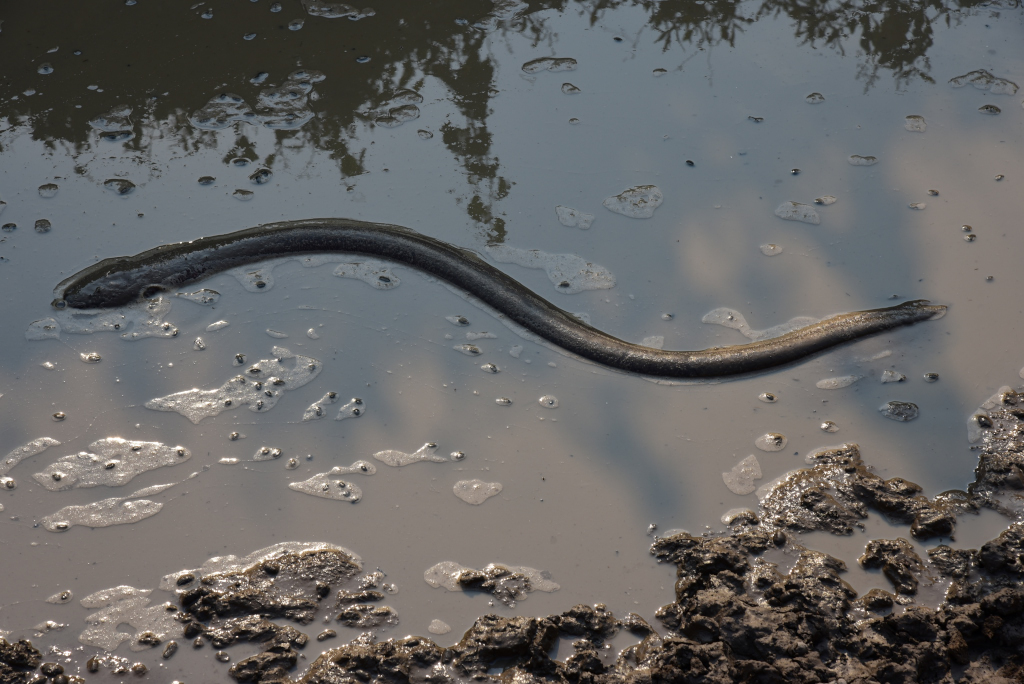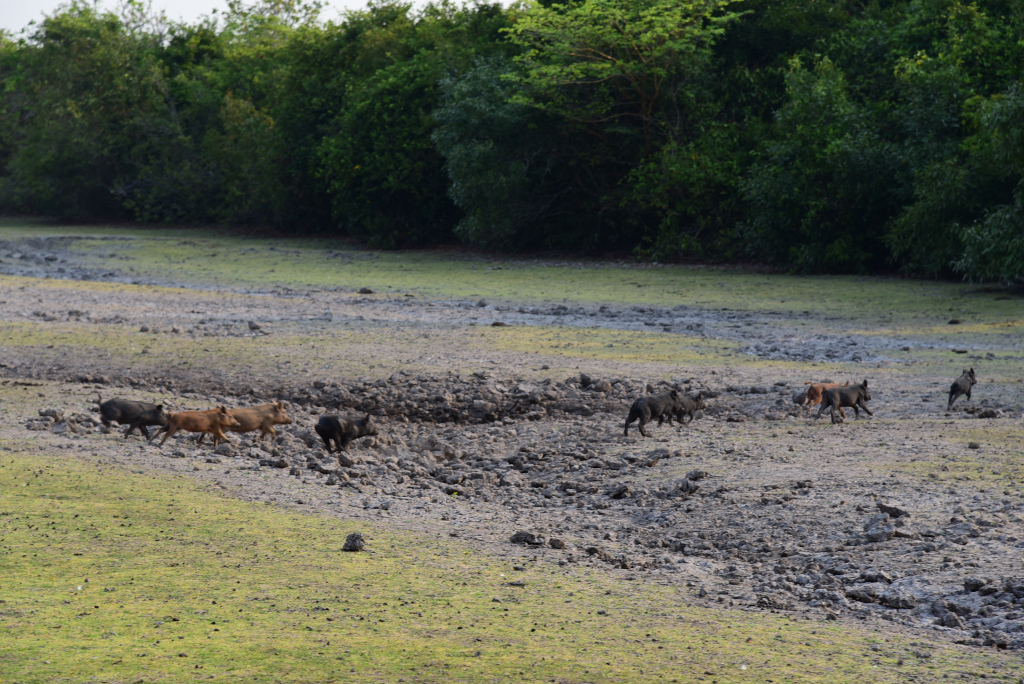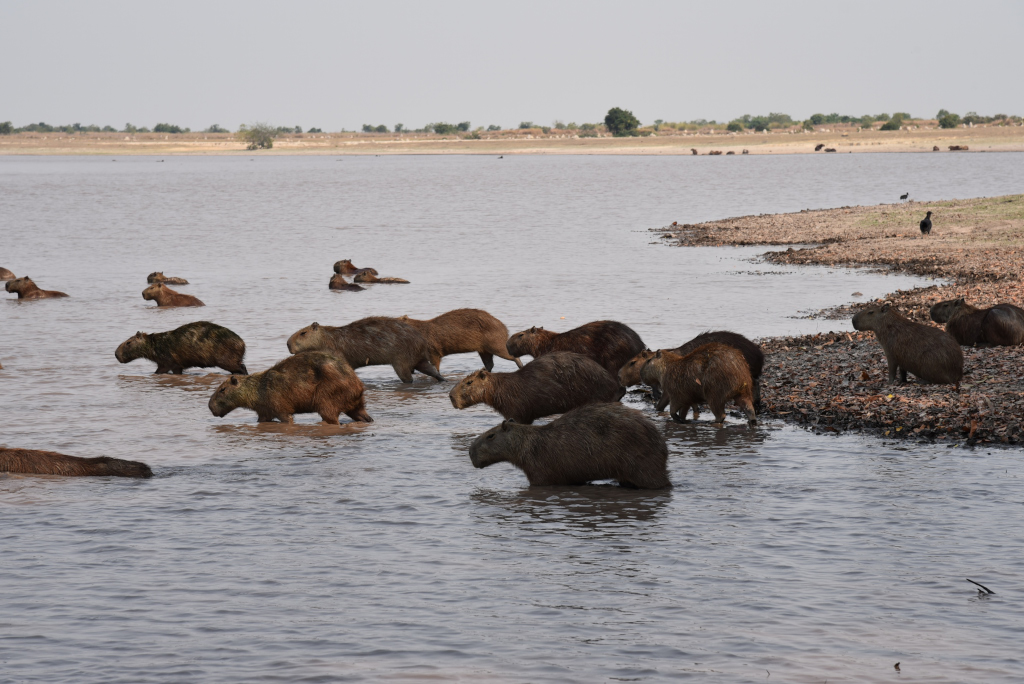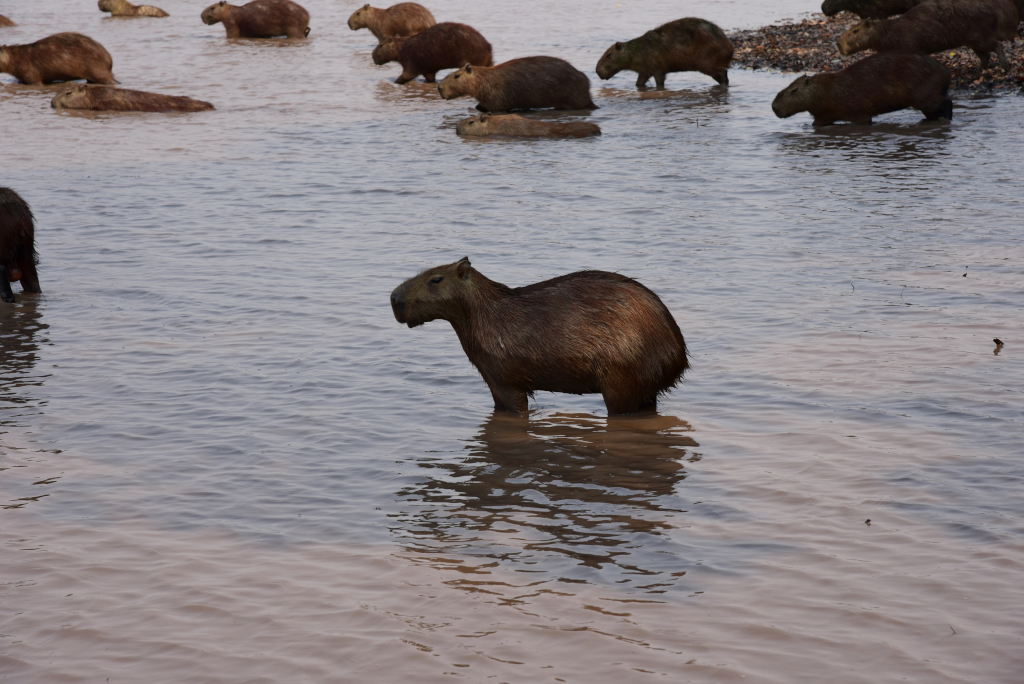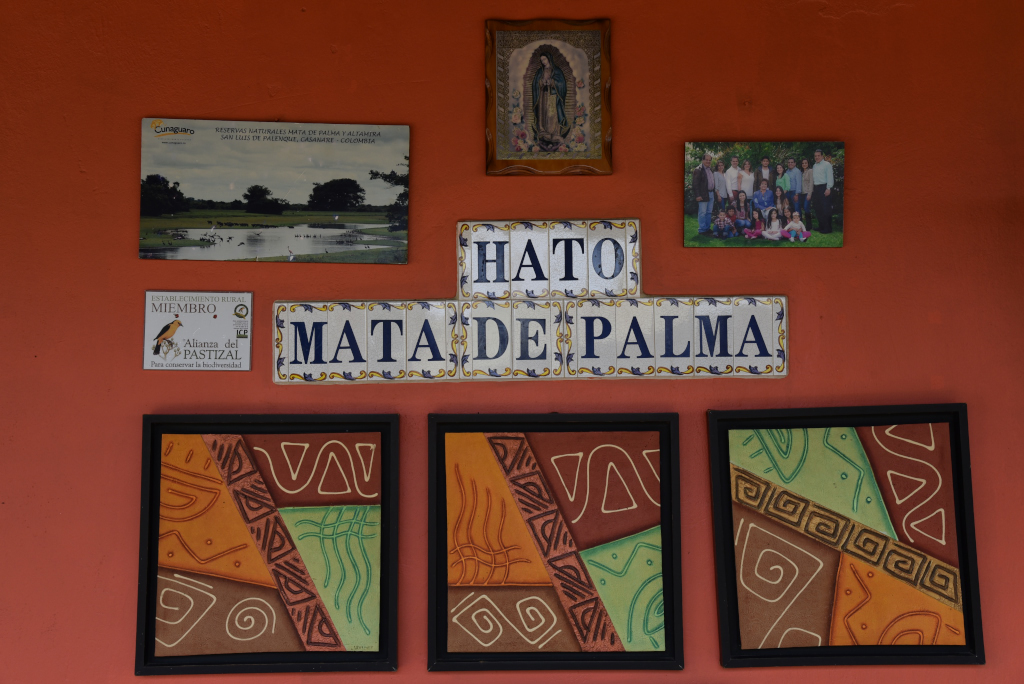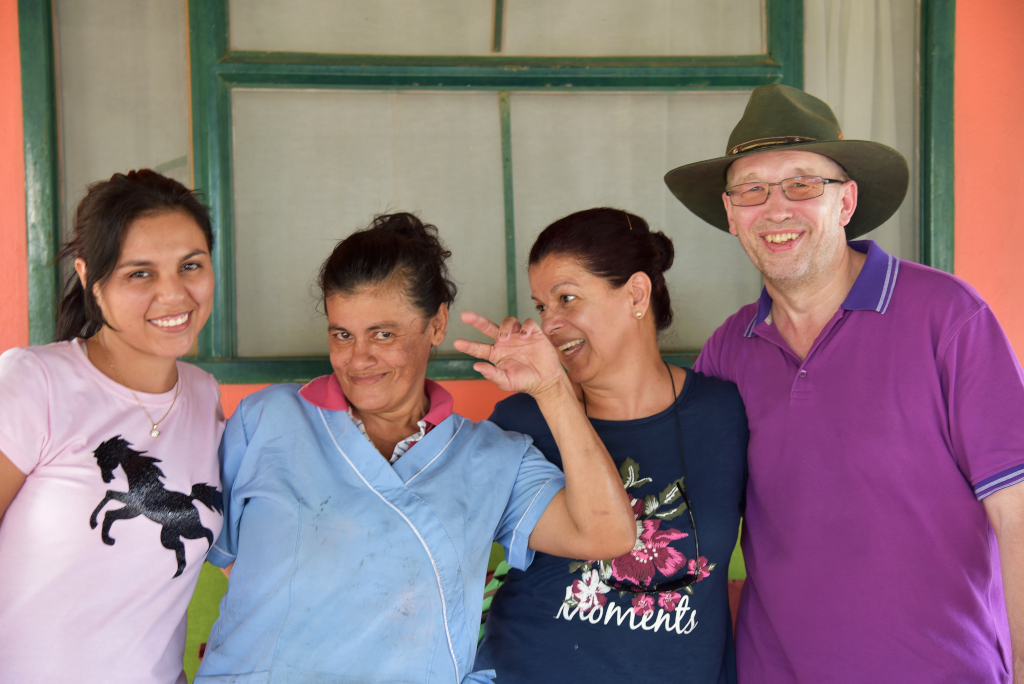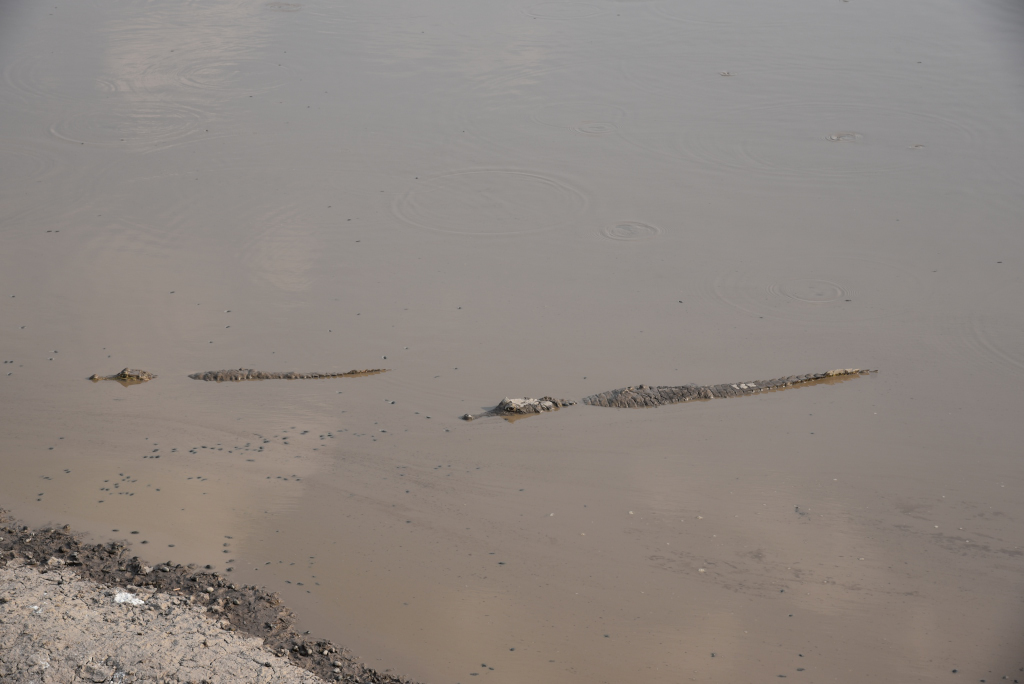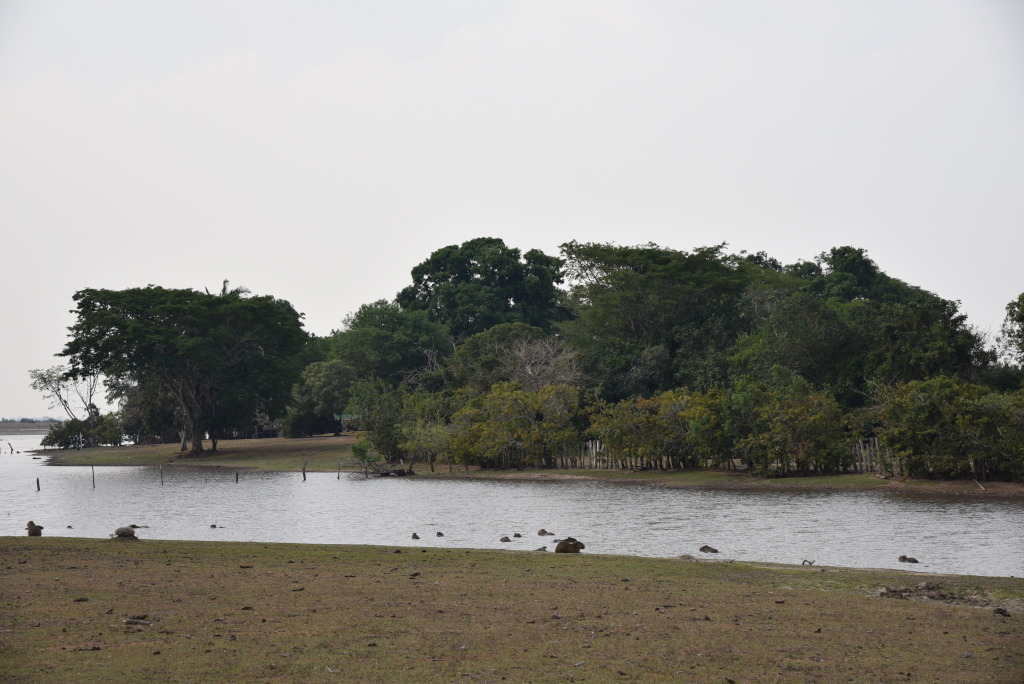March, 2018
Four in the morning is far too early for a person like myself to feel comfortable waking up, unless it were for the purpose of falling asleep again. But no, I have to haul my sorry presence into the cab of a waiting vehicle, and it certainly would be quite offensive to the driver and guide for me to complain to them about having to get up so early, given that they probably were up even earlier. And yet they hardly look that tired. We pick up a couple at another hotel, and Doña Carmen and her husband Rolf. She is originally from Cali, but has lived for some 25 years with her German husband in Wuppertal. They come to Colombia every year, and have done some very in-depth traveling here as a result. I may be here for some three months, but my trip really involves just scratching the surface, not that I am complaining!
Around us, barren fields of scrub, punctuated with a light scattering of small trees, occasional plots of tilled soil waiting to be seeded. Cow herds roam on the expansive pastureland, space in surfeit relative to the constrained space available to cattle farms in the mountains to the north. The sun’s flaming red disk emerges briefly at dawn, then dissipates into the haze of the day.
The journey to the finca where we were are intended to partake in some sort of safari is long, two hours along desolate and largely straight roads into the emerging dawn, and beyond into the early morning. Carmen is a lively and charming conversationalist, interesting, engaging, humorous and passionate, but not overbearing. She dominates the conversation the entire day, but no one seems to be particularly concerned. The locals certainly won’t be, given that they are making good money from our presence. Then considering their utterly relaxed nature, they probably wouldn’t care very much either way.
Now our first sightings of wildlife, the oh-so-cute anteaters waddling along in the fields next to us, anything but exotic in these parts. The good news is that other than being hunted for their meat by humans, the larger mammals here are not under threat. And as our guide explains to us, there is hardly much incentive to hunt capybaras, for example, since people are already quite well-fed as it is.
After hours of driving, we leave the paved road, ambling along a rough dirt road surrounded by scrub on one side, and regularly-spaced oil palms on the other. The rising heat is already getting to me. Moreover, I can’t seem to identify the various bird species and animals that Carmen and the guide have spotted among the oil palms. We soon come to a halt, a slender spectacled caiman vanishing up to an adjacent muddy pool, where a huge eel wallows slowly in the mud, in the process of dying. The receding waters of the dry season spell the death knell of much of the wildlife, which resurges once the summer rains return.
Following a path through the brush, we silently emerge upon a clearing in which a herd of wild pigs is gathered, which upon becoming apprised of our presence, flees in a running cordon into the bushes. A panicked young specimen emerges from the bushes later on in our walk, running frantically in the direction of the pack that has now disappeared, not that the poor thing has much to be afraid of from the camera-wielding tourists. The flock of egrets stand primly around the shoreline of the lagoon, their white bodies clearly reflected in the water.
As we approach, they spread their large wings and rise into the sky, wheeling uniformly to a further location, so that irrespective of how far we have walked, the egrets are only visible in the distance, and never too close. At the far end of the lagoon, the forest closes in on us again, but the guide wants to verify that the one thing Carmen has been obsessing with is in fact not on hand, and that is an anaconda. He finally re-emerges from the scrub to tell us that we are out of luck, and hence we need to return to the vehicle to continue our adventures.
What seems strange about the capybara is that it seems like a rat on steroids, without the tail – and it is in fact the largest rodent species in existence. Unlike rats, capybaras have little intention of moving anywhere too fast, and tend to spend a lot of time out in the open, be it on land or in the water, although they probably go into hiding when feeling threatened.
Adult capybaras grow up 3 1/2 to 4 1/2′ in length, stand 20 to 24 ” tall, and typically weigh 75 to 150 lbs. Capybaras are herbivores, and prefer open savanna and cattle ranches, along the lines of the environments we visit today. Without natural predators, the animals are assured a relatively long lifespan, although in the absence of water in the protracted dry season, capybaras tend to die of dehydration.
The information I was conveyed about the llanura prior to coming here was one of potential lack of security, a Wild West environment in which safety could not be assured. But what I am seeing here is everything but, a world that is relaxed, stable and welcoming. But the years under Uribe were different, rife with the presence of militias and violent land-grabs. Particularly now that the FARC has moved from military to political engagement, the difficulties of the past will hopefully not re-emerge. However, given the Senate, Assembly and Presidential elections being held this election year, Uribe’s legacy may again rear its ugly head.
We arrive at the compound that marks the centre of the Hato Mata de Palma. The garden of the finca provides a pleasant respite from the drab, scruffy overheated landscape we have traversed, with its houses, fruit trees, flowering bushes, including torch ginger and hibiscus, the animal life bleeding into the human settlement with the presence of the occasional chicken, pig or capybara wandering through.
The yard offers views of the lake that meanders along the confines of the compound before arcing away. Hammocks have been slung around the smaller house, and on one side are rocking chairs, a table and small couch set on the small terrace. The house includes two spacious rooms, the one on the lakeside ample, with three four-poster beds, wall-hangings, heavy, hand-carved wooden armoires, altogether very impressive.
And from the housing compound, we are meant to walk along the periphery of the lagoon. Herds of capybara emerge before us, exotic, mutant rats that amble slowly towards the lake, fixated on the water before them, then in the water swimming methodically to some position closer to the centre, unperturbed by the small caimans floating nearby. The capybara are also not particularly perturbed by the presence of humans, certainly not these, who live permanently on the finca.
While the dry season threatens to decimate the population, it springs back in the wet season. And yet when the population grows too much, it also places a substantial burden on the environment, beginning with the polluting of the waters they frequent.
As we walk along the periphery of the lagoon, the guide tells us that by far the most fit people who visit the area are North Americans. I roll my eyes, barely able to contain my commentary. The people who visit you, perhaps, but they are hardly representative of the average North American. But there is always room for optimism. Meanwhile, at the appropriate moments of the day, Carmen can hardly resist referring to myself and Rolf as ‘you strong northern men’ in a voice laden with droll intent.
For some spurious reason I have been consistent in my message that it is not that hot here. It is in fact hot, hot to the point that I feel I am slowly cooking inside, and that I want to just be anywhere or doing anything that does not involve this level of temperature and humidity. People complain about the heat as if it is some highly unusual and rare occurrence, but in this region, the heat and humidity must be omnipresent.
On the far side of the lagoon, we see elegant ibises and the stunning roseate spoonbills, the pink wash of their feathers erupting as they splay their wings and arc skywards. It is difficult to get great shots of the birds from this distance, but they are clearly visible to the naked eye, their impression heightened by their reflections in the lagoon. Smaller birds abound on the shoreline and bushes, although I lose track of the explanations the guide is providing. Mallards, canary-like birds, egrets, and others, scurrying along the ground, circling the crests of the trees, their lives bucolic in these simmering flatlands bereft of predators.
We progress to the far end of the lagoon, then veer away onto the barren fields, trudging slowly in the growing heat along the barbed wire fence, the guide pointing out the various tree species, yopo and yopal, after which the town has been named, the uses of the trees, not to forget the local variant of coca. We head back to the compound, and can’t get there soon enough, as I am beginning to suffer serious heat exhaustion.
I greedily eye the drink that Amparo prepares from behind the kitchen counter, but the amount of panela mixed in with orange juice will hardly help with rehydration. Winking coyly as she bustles around the kitchen, she asks me if I want another tintico. Probably the last thing I should be drinking, but I feel utterly bedraggled and miserable. Anything with air con though would be perfect!
As we wait for the lunch to be served, an older ranch hand sits down across from me, our conversation degenerating into his rambling musing about the state of things at the hato, although much of what he conveys is too incoherent for me to grasp. One of the morsels I do understand includes that the price of cattle has dropped substantially since Alvaro Uribe decided to get into a trade war with Hugo Chavez, severing commercial relations between the Venezuela and Colombia, although it is not clear to what extent that would still applicable today, with Colombia under Santos. It would certainly make sense that Venezuela wouldn’t have much economic clout to even buy Colombia’s cattle, but I am not going to try to pursue that subject now.
A man I presume to be the owner of the finca watches us as we eat, a cowboy hat clamped firmly over his head, his slow drawling voice belying his somewhat intent expression. If he were any more relaxed, he would be falling asleep. He slowly recounts stories of life in the llanura, including stories laden with superstition at Carmen’s behest.
Rolf and Carmen manage to eat their lunches quickly, but I struggle with the tough chicken meat, not that the heat hasn’t drained my ability to eat, never mind pay attention to any social graces. Carmen urges me continuously to eat with my hands, which I normally would, but it is so hot and I am so sweaty that I don’t want to layer grease onto my sweaty skin.
Despite the debilitating heat, we have seen quite a few animal species, particularly birds. Well, the other members of our group have, in any case, the guide having rattled off the names of the birds that were flying in and out of the bushes. I encourage him to enumerate the species of birds we had seen off of the placard on the cabin wall, and the list he provides is quite daunting:
- Roseate spoonbill (platulea ajaja)
- Grey heron (Ardea alba)
- Wood stork (mycteria americana)
- Bare-faced ibis (phimosus infuscatus)
- Sharp-tailed Ibis (cercibis oxycera)
- Jabiru (jabiru mycteria)
- Grey-necked wood rail (aramides cajaneus)
- Wattled jacana (jacana jacana)
- Brazilian teal (amazonetta brasiliensis)
- Orinoco goose (neochen jubata)
- Buff-necked ibis (theristicus caudatus)
- Sun bittern (eurypyga helias)
- Greater yellowlegs (tringa melanoleuca)
- Lesser yellow-headed vulture (cathartes burrovianus)
- Oriole blackbird (gymnomystax mexicanus)
- Large-billed tern (phaetusa simplex)
- Black-bellied whistling duck (dendrocygna autumnalis)
I have no choice but to lie in one of the hammocks offered. Of course, Amparo won’t let me be, I have to turn around, then realign my position. I meant to take notes, but I drift off to sleep, and awaken to Amparo calling my name. At least I feel better: there is nothing more constructive to do in the heat than sleep, although if it were really that hot, even sleep would be difficult.
We are now meant to continue on our trip, but first order of business is to ensure the expensive trip is paid off in full, and then take in the obligatory photo shoot. Well, hardly obligatory, since I usually forget to take photos of people I encounter, and end up taking photos of exclusively buildings.
We pile back into the truck, the best part of the day the functional air conditioning. But we are not going too far, only to the fenced compound on the far side of the lagoon, apparently to see some owls that spend their time in some trees that are some of the last of the species in the country. Positioning ourselves under the towering palms, we spot several of what I presume to be the South American great horned owl, the body relatively inert as the head pivots in the direction of our group, swiveling back and forth.
As the others migrate back to the truck, I can’t resist trying to take some photos of the buff-necked ibis circling between the upper branches of a tall, desiccated tree, although predictably, the optics of my camera simply are not that favorable, nor are the light conditions.
And not far beyond, catering to Carmen’s obsession with finding an anaconda, the guide motions us to stop on a bridge crossing a small creek filled with rubble and a tangle of branches, where there may be a possibility of finding precisely such a creature. It is in fact present, the six-metre snake hidden under the branches in the water.
What ensues is itself quite entertaining, the rest of the group rolling its eyes as the guide and Carmen clamber over the branches and carefully weave their arms through the tangle for the purpose of touching the body apparently barely submerged under the water. Then the anaconda’s head emerges near the surface somewhere else, and no one is in a rush to touch the creature’s head. Thankfully, it is not aggressive, preferring to hide under water until suitable prey makes itself available – and we are certainly not that suitable prey.
We slowly amble along the rough dirt road, the golden scrub around us culminating in patches of forest in the distance, the property demarcated by the ubiquitous barbed wire fence. It would seem we are heading to some other housing compound on some expansive adjacent property, but we continue on at slow speed, the vehicle rocking gently as we attempt to navigate the heavily corrugated trail.
Just when it would seem we should be disembarking, we continue even further, into a greater unknown, and then at a gate, into a vast expanse of raw dirt, mud, and scrub grasses that few animals would consume. These fincas may be vast, but much of the terrain unusable for grazing purposes. Herds of capybaras migrate across the broad landscape, the scattered young loping after their fattened elders, deer racing across the horizon and vanishing into distant bushes.
And finally, broaching a slightly raised mud flat, cordons of mud-drenched capybara depart for the forest, abandoning the muddied waters of the trench below us to the small spectacled caimans drifting in the water, seemingly inert, their watchful eyes peering above the water line, the rest of the bodies submerged.
Around us, as far as the eye can see, dried mud, which becomes an ocean of water in the rainy season, in fact, much of the land altogether underwater as the land springs to life. In the dry season, on the other hand, the few remaining bodies of water visible need to support the dwindling and increasingly desperate wildlife.
Back on the rough undulating trail, more deer and capybara amidst the scrub grasses, and a pair of utterly cute burrowing owls staring at us in amazement while hopping along near the road. And then the parched landscape becomes verdant again, thick, verdant bushes rising from the closely cropped grass, behind which lies a depression lined with a populous herd of capybara, busily munching away at the little grass that remains, a handful bathing in the pool at the far end.
We continue, but it is now late in the afternoon, and the light is falling. Slowly proceeding along the rough road, a much longer lagoon emerges to our right, the stunning spectacle of roseate spoonbills and bleached ibises lining the shoreline, their bodies reflected in the clear water. Attempting to approach for a better view is pointless: they spread their wings, rise up into the air, wheeling into the skies, and then are gone, not too far away, but far away from the roving photographer.
At another finca, we stop off for more sweet panela drink, and are off, on our last leg of the day, back to the carretera. We quickly inspect some of the rooms of the compound, but I don’t want to delay – the sun is setting and we still need several hours to get back to Yopal. Surprisingly, the place is booked solid with Germans and other Europeans, some of whom come here for weeks on end. So much for Casanare being off the beaten track – for the experienced visitors in the know, this is the place to be!
I watch the clock on the dashboard of the truck, counting the minutes as they pass, wanting to have returned to Yopal hours ago, when we were supposed to. My evening will have been hijacked by the late return, which puts me in somewhat of an unwelcoming mood. I had intended on finally resolving the lack of communication with the third AirBnb host, potentially having to cancel and start yet again with the booking, a time-consuming and troubling process, never mind working on my blog after being utterly exhausted from the day’s heat, and most importantly, getting something decent to eat before restaurants close in Yopal.
Mumbling a few closing comments into the cab of the vehicle, I run into the hotel, try not to get in too deep of an interaction with the dour receptionist, rush up to my room, throw on the air conditioning, change, drink copious amounts of cold fluid, then am out the door again, and following a few purchases at the Exito, find myself some four blocks to the east at the Mai Mai burger establishment, which I have to admit prepares a very good burger, and given the alternatives for food in the evening, it is certainly not the worst choice.
The other attraction of the country awaits me upon my return to the hotel, namely the political gatherings, a stage set up for the Partido Verde involving a jarring joropo band, the well-endowed singer crooning about the bonds between a man and woman, and that a healthy relationship should only be between people of the opposite sex, which I find interesting to be promoted at this particular party’s gathering. A few blocks further, and bereft of music, speakers are imploring the crowd gathered across the entirety of the boulevard to vote for the Partido Criollo, which attracts a crowd of largely country folk, at least based on the appearance of the participants and the ubiquitous sombrero worn in the llanura.












